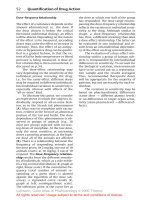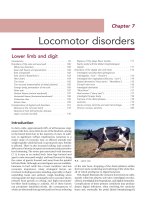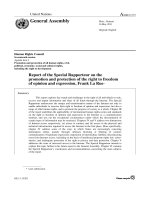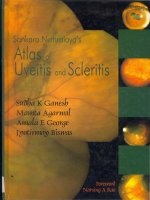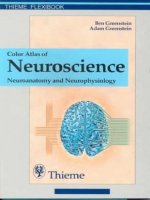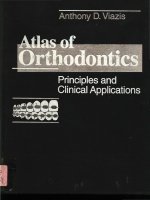6 atlas of neuroanatomy and neurophysiology frank h netter
Bạn đang xem bản rút gọn của tài liệu. Xem và tải ngay bản đầy đủ của tài liệu tại đây (12.77 MB, 98 trang )
Atlas of
Neuroanatomy and
Neurophysiology
Selections from the Netter Collection of Medical Illustrations
Illustrations by
Frank H. Netter, MD
John A. Craig, MD
James Perkins, MS, MFA
Text by
John T. Hansen, PhD
Bruce M. Koeppen, MD, PhD
Atlas of Neuroanatomy and Neurophysiology
Selections from the Netter Collection of Medical Illustrations
Copyright ©2002 Icon Custom Communications. All rights reserved.
The contents of this book may not be reproduced in any form without written
authorization from Icon Custom Communications. Requests for permission
should be addressed to Permissions Department, Icon Custom Communications,
295 North St., Teterboro NJ 07608, or can be made at www. Netterart.com.
NOTICE
Every effort has been taken to confirm the accuracy of the information presented.
Neither the publisher nor the authors can be held responsible for errors or for any
consequences arising from the use of the information contained herein, and make
no warranty, expressed or implied, with respect to the contents of the publication.
Printed in U.S.A.
Foreword
Frank Netter: The Physician, The Artist, The Art
This selection of the art of Dr. Frank H. Netter on neuroanatomy and neurophysiology is drawn
from the Atlas of Human Anatomy and Netter’s Atlas of Human Physiology. Viewing these pictures
again prompts reflection on Dr. Netter’s work and his roles as physician and artist.
Frank H. Netter was born in 1906 in New York City. He pursued his artistic muse at the Sorbonne,
the Art Student’s League, and the National Academy of Design before entering medical school at
New York University, where he received his M.D. degree in 1931. During his student years, Dr.
Netter’s notebook sketches attracted the attention of the medical faculty and other physicians, allowing him to augment his income by illustrating articles and textbooks. He continued illustrating as a
sideline after establishing a surgical practice in 1933, but ultimately opted to give up his practice in
favor of a full-time commitment to art. After service in the United States Army during the Second
World War, Dr. Netter began his long collaboration with the CIBA Pharmaceutical Company (now
Novartis Pharmaceuticals). This 45-year partnership resulted in the production of the extraordinary
collection of medical art so familiar to physicians and other medical professionals worldwide.
When Dr. Netter’s work is discussed, attention is focused primarily on Netter the artist and only
secondarily on Netter the physician. As a student of Dr. Netter’s work for more than forty years, I can
say that the true strength of a Netter illustration was always established well before brush was laid to
paper. In that respect each plate is more of an intellectual than an artistic or aesthetic exercise. It is
easy to appreciate the aesthetic qualities of Dr. Netter’s work, but to overlook its intellectual qualities is to miss the real strength and intent of the art. This intellectual process requires thorough understanding of the topic, as Dr. Netter wrote: “Strange as it may seem, the hardest part of making a medical picture is not the drawing at all. It is the planning, the conception, the determination of point of
view and the approach which will best clarify the subject which takes the most effort.”
Years before the inception of “the integrated curriculum,” Netter the physician realized that a
good medical illustration can include clinical information and physiologic functions as well as anatomy. In pursuit of this principle Dr. Netter often integrates pertinent basic and clinical science elements in his anatomic interpretations. Although he was chided for this heresy by a prominent
European anatomy professor, many generations of students training to be physicians rather than
anatomists have appreciated Dr. Netter’s concept.
The integration of physiology and clinical medicine with anatomy has led Dr. Netter to another,
more subtle, choice in his art. Many texts and atlases published during the period of Dr. Netter’s
career depict anatomy clearly based on cadaver specimens with renderings of shrunken and shriveled tissues and organs. Netter the physician chose to render “live” versions of these structures—not
shriveled, colorless, formaldehyde-soaked tissues, but plump, robust organs, glowing with color!
The value of Dr. Netter’s approach is clearly demonstrated by the plates in this selection.
John A. Craig, MD
Austin, Texas
This volume brings together two distinct but related aspects of the work of Frank
H. Netter, MD, and associated artists. Netter is best known as the creator of the
Atlas of Human Anatomy, a comprehensive textbook of gross anatomy that has
become the standard atlas for students of the subject. But Netter’s work included
far more than anatomical art. In the pages of Clinical Symposia, a series of monographs published over a period of more than 50 years, and in The Netter Collection
of Medical Illustrations, this premier medical artist created superb illustrations of
biological and physiological processes, disease pathology, clinical presentations,
and medical procedures.
As a service to the medical community, Novartis Pharmaceuticals has commissioned this special edition of Netter’s work, which includes his beautiful and
instructive illustrations of nervous system anatomy as well as his depictions of
neurophysiological concepts and functions. We hope that readers will find Dr.
Netter’s renderings of neurological form and function interesting and useful.
Click any title below to link to that plate.
Part 1 Neuroanatomy
Cerebrum—Medial Views . . . . . . . . . . . . . . . . . 2
Cerebrum—Inferior View. . . . . . . . . . . . . . . . . . 3
Basal Nuclei (Ganglia). . . . . . . . . . . . . . . . . . . . 4
Thalamus . . . . . . . . . . . . . . . . . . . . . . . . . . . . . . 5
Cerebellum . . . . . . . . . . . . . . . . . . . . . . . . . . . . 6
Brainstem . . . . . . . . . . . . . . . . . . . . . . . . . . . . . . 7
Fourth Ventricle and Cerebellum . . . . . . . . . . . 8
Accessory Nerve (XI) . . . . . . . . . . . . . . . . . . . . 9
Arteries to Brain and Meninges . . . . . . . . . . . 10
Arteries to Brain: Schema . . . . . . . . . . . . . . . . 11
Oculomotor (III), Trochlear (IV)
and Abducent (VI) Nerves: Schema. . . . . . . 27
Trigeminal Nerve (V): Schema . . . . . . . . . . . . 28
Facial Nerve (VII): Schema . . . . . . . . . . . . . . . 29
Vestibulocochlear Nerve (VIII): Schema. . . . . 30
Glossopharyngeal Nerve (IX): Schema . . . . . . 31
Vagus Nerve (X): Schema . . . . . . . . . . . . . . . . 32
Accessory Nerve (XI): Schema . . . . . . . . . . . . 33
Hypoglossal Nerve (XII): Schema . . . . . . . . . . 34
Nerves of Heart . . . . . . . . . . . . . . . . . . . . . . . . 35
Arteries of Brain: Inferior Views . . . . . . . . . . . 12
Autonomic Nerves
and Ganglia of Abdomen. . . . . . . . . . . . . . . 36
Cerebral Arterial Circle (Willis) . . . . . . . . . . . 13
Nerves of Stomach and Duodenum . . . . . . . . 37
Arteries of Brain: Frontal View and Section . . 14
Nerves of Stomach
and Duodenum (continued) . . . . . . . . . . . . 38
Arteries of Brain:
Lateral and Medial Views . . . . . . . . . . . . . . . 15
Nerves of Small Intestine . . . . . . . . . . . . . . . . 39
Arteries of Posterior Cranial Fossa . . . . . . . . . 16
Nerves of Large Intestine . . . . . . . . . . . . . . . . 40
Veins of Posterior Cranial Fossa . . . . . . . . . . . 17
Deep Veins of Brain. . . . . . . . . . . . . . . . . . . . . 18
Nerves of Kidneys,
Ureters and Urinary Bladder . . . . . . . . . . . . 41
Subependymal Veins of Brain . . . . . . . . . . . . . 19
Nerves of Pelvic Viscera: Male . . . . . . . . . . . . 42
Hypothalamus and Hypophysis . . . . . . . . . . . 20
Nerves of Pelvic Viscera: Female . . . . . . . . . . 43
Arteries and Veins
of Hypothalamus and Hypophysis . . . . . . . . 21
Median Nerve . . . . . . . . . . . . . . . . . . . . . . . . . 44
Relation of Spinal Nerve Roots to Vertebrae . . . 22
Radial Nerve in Arm
and Nerves of Posterior Shoulder . . . . . . . . 46
Autonomic Nervous System:
General Topography. . . . . . . . . . . . . . . . . . . 23
Spinal Nerve Origin: Cross Sections. . . . . . . . 24
Olfactory Nerve (I): Schema . . . . . . . . . . . . . . 25
Optic Nerve (II)
(Visual Pathway): Schema . . . . . . . . . . . . . . 26
Ulnar Nerve . . . . . . . . . . . . . . . . . . . . . . . . . . . 45
Radial Nerve in Forearm . . . . . . . . . . . . . . . . . 47
Sciatic Nerve and Posterior
Cutaneous Nerve of Thigh . . . . . . . . . . . . . . 48
Tibial Nerve . . . . . . . . . . . . . . . . . . . . . . . . . . . 49
Common Fibular (Peroneal) Nerve. . . . . . . . . 50
NEUROANATOMY
Sagittal section of
brain in situ
Cingulate gyrus
Cingulate sulcus
Medial frontal gyrus
Sulcus of corpus callosum
Fornix
Septum pellucidum
Interventricular
foramen (Monro)
Interthalamic
adhesion
Thalamus and
3rd ventricle
Subcallosal
(parolfactory)
area
Anterior
commissure
Subcallosal
gyrus
Hypothalamic
sulcus
Lamina
terminalis
Supraoptic
recess
Optic chiasm
Tuber cinereum
Hypophysis (pituitary gland)
Mammillary body
Cerebral peduncle
Pons
Medial surface of cerebral
hemisphere: brainstem excised
Cingulate gyrus
Mammillothalamic
fasciculus
Mammillary body
Cerebrum: Medial Views
Paracentral sulcus
Central sulcus (Rolando)
Paracentral lobule
Marginal sulcus
Corpus callosum
Precuneus
Superior sagittal sinus
Choroid plexus
of 3rd ventricle
Stria medullaris
of thalamus
Parietooccipital
sulcus
Cuneus
Habenular
commissure
Pineal body
Posterior
commissure
Calcarine
sulcus
Straight sinus
in tentorium
cerebelli
Cerebral aqueduct
(Sylvius)
Great cerebral vein
(Galen)
Superior colliculus
Inferior colliculus
Tectal (quadrigeminal) plate
Cerebellum
Superior medullary velum
4th ventricle and choroid plexus
Inferior medullary velum
Medulla oblongata
Genu
Rostrum
Trunk
Splenium
of
corpus callosum
Isthmus of cingulate gyrus
Parietooccipital sulcus
Cuneus
Uncus
Calcarine sulcus
Optic nerve (II)
Lingual gyrus
Olfactory tract
Crus
Body
Column
Collateral sulcus
Rhinal sulcus
Medial occipitotemporal gyrus
Occipitotemporal sulcus
Lateral occipitotemporal gyrus
2
of fornix
Fimbria of hippocampus
Dentate gyrus
Parahippocampal gyrus
NEUROANATOMY
Cerebrum: Inferior View
Sectioned brainstem
Frontal pole of cerebrum
Straight gyrus
Olfactory sulcus
Orbital sulci
Longitudinal cerebral fissure
Genu of corpus callosum
Lamina terminalis
Olfactory bulb
Olfactory tract
Orbital gyri
Optic chiasm
Temporal pole
Optic nerve (II) (cut)
Lateral sulcus (Sylvius)
Hypophysis
(pituitary gland)
Inferior temporal sulcus
Inferior temporal gyrus
Anterior
perforated substance
Optic tract
Tuber cinereum
Mammillary body
Inferior (inferolateral) margin
of cerebrum
Posterior perforated
substance (in
interpeduncular
fossa)
Rhinal sulcus
Cerebral crus
Uncus
Lateral geniculate
body
Inferior
temporal gyrus
Substantia nigra
Medial geniculate
body
Occipitotemporal
sulcus
Red nucleus
Lateral occipitotemporal gyrus
Pulvinar of thalamus
Superior colliculus (of
corpora quadrigemina)
Collateral sulcus
Cerebral aqueduct
Parahippocampal gyrus
Splenium of corpus callosum
Medial occipitotemporal gyrus
Calcarine sulcus
Apex of cuneus
Occipital pole of cerebrum
Longitudinal cerebral fissure
Isthmus of cingulate gyrus
3
NEUROANATOMY
Horizontal sections
through cerebrum
Basal Nuclei (Ganglia)
A
B
Genu of corpus callosum
Head of caudate nucleus
Lateral ventricle
Anterior limb
of internal
capsule
Genu
Septum pellucidum
Posterior limb
Column of fornix
Putamen
Globus pallidus
Insula
(island of Reil)
Lentiform
nucleus
3rd ventricle
Interthalamic
adhesion
External capsule
Thalamus
Claustrum
Crus of fornix
Retrolenticular part
of internal capsule
Choroid plexus
of lateral ventricle
Tail of caudate nucleus
Hippocampus and fimbria
Splenium of
corpus callosum
Occipital (posterior) horn
of lateral ventricle
Habenula
Organization of
basal nuclei (ganglia)
A
B
Caudate Putamen Globus
nucleus
pallidus
Striatum
Lentiform
nucleus
Corpus
striatum
Basal nuclei
(ganglia)
Pineal body
Cleft for internal capsule
Caudate
nucleus
Levels of
sections
above
Body
Head
A
B
Thalamus
A
B
Pulvinar
Lentiform nucleus
(globus pallidus medial
to putamen)
Amygdaloid body
Medial geniculate body
Lateral geniculate body
Tail of caudate nucleus
Interrelationship of thalamus, lentiform nucleus, caudate
nucleus and amygdaloid body (schema): left lateral view
4
NEUROANATOMY
Thalamus
Corpus callosum (cut)
Interventricular foramen (Monro)
Head of caudate nucleus
Tela choroidea (cut edge)
of 3rd ventricle
Septum pellucidum
3rd ventricle
Columns of fornix
Choroid plexus
Anterior tubercle
Superior thalamostriate vein
Stria terminalis
Pes hippocampi
Interthalamic adhesion
Temporal (inferior) horn
of lateral ventricle
Lamina affixa
Internal cerebral vein
Stria medullaris
Dentate gyrus
Habenular trigone
Collateral eminence
Pulvinar (retracted)
Hippocampus
Lateral geniculate body
Fimbria of hippocampus
Medial geniculate body
Posterior commissure
Brachium of superior colliculus
Habenular commissure
Brachium of inferior colliculus
Pineal body
Collateral trigone
Superior colliculus
Calcar avis
Inferior colliculus
Occipital (posterior) horn
of lateral ventricle
Cerebellum
Calcarine sulcus
3rd ventricle
Internal
medullary
lamina
Interthalamic
adhesion
a
Pulvinar
rio
r
MD
LP
M
Intralaminar
nuclei
Inte
LP
3rd ventricle
VPL
M
External
medullary
lamina
VP
Median nuclei
Schematic section
through thalamus
(at level of broken
line shown in figure
at right)
Thalamic nuclei
CM
LD
LP
M
MD
VA
VI
VL
VP
VPL
VPM
Centromedian
Lateral dorsal
Lateral posterior
Medial
Medial dorsal
Ventral anterior
Ventral intermedial
Ventral lateral
Ventral posterior
Ventral posterolateral
Ventral posteromedial
VL
VP
Reticular nucleus
VP
CM
rn
L
VA
La
m
in
n
te
An
dia
Me ial
d
na
Me llar y lami
u
d
D
e
L
al m
VP
M
VI
Pulvinar
Lateral geniculate body
Medial geniculate body
Schematic representation of thalamus
(external medullary lamina and
reticular nuclei removed)
Lateral nuclei
Medial nuclei
Anterior nuclei
5
NEUROANATOMY
Cerebellum
Superior surface
Anterior cerebellar notch
Anterior lobe
Quadrangular lobule (H IV-V)
Central lobule (II & III)
Primary fissure
Horizontal fissure
Culmen (IV & V)
Simple lobule (H VI)
Superior
vermis
Posterior lobe
Declive (VI)
Postlunate fissure
Folium (VII A)
Superior semilunar
(anseriform) lobule (H VII A)
Horizontal fissure
Inferior semilunar
(caudal) lobule (H VII B)
Posterior cerebellar notch
Central lobule
Superior vermis
Anterior lobe
Inferior surface
Wing of central lobule
Lingula (I)
Superior
Middle
Inferior
Superior medullary velum
Flocculus (H X)
Flocculonodular lobe
4th ventricle
Posterolateral (dorsolateral)
fissure
Inferior medullary velum
Retrotonsillar fissure
Nodule (X)
Inferior
vermis
Cerebellar peduncles
Posterior lobe
Uvula (IX)
Pyramid (VIII)
Tuber (VII B)
Posterior cerebellar notch
Decussation of
superior cerebellar peduncles
Tonsil
Biventer lobule (H VIII)
Secondary (postpyramidal)
fissure
Horizontal fissure
Inferior semilunar
(caudal) lobule (H VII B)
Cerebral crus
Medial longitudinal fasciculus
4th ventricle
Nuclear layer of
medulla oblongata
Superior medullary velum
Fastigial
Cerebellar
nuclei
Superior cerebellar
peduncle
Globose
Lingula (I)
Dentate
Vermis
Emboliform
Section in plane of superior cerebellar peduncle
6
NEUROANATOMY
Brainstem
Thalamus (cut surface)
Posterolateral view
Lateral geniculate body
Optic tract
Pulvinars of thalami
Pineal body
Medial geniculate body
Superior colliculi
Brachia of superior and inferior colliculi
Inferior colliculi
Cerebral crus
Trochlear nerve (IV)
Pons
Superior medullary velum
Trigeminal nerve (V)
Superior cerebellar peduncle
Middle cerebellar peduncle
Rhomboid fossa of
4th ventricle
Vestibulocochlear nerve (VIII)
Facial nerve (VII)
Glossopharyngeal (IX) and
vagus (X) nerves
Inferior cerebellar peduncle
Cuneate tubercle
Hypoglossal nerve (XII)
Gracile tubercle
Accessory nerve (XI)
Dorsal roots of
1st spinal nerve (C1)
Cuneate fasciculus
Gracile fasciculus
Olfactory tract
Anterior view
Anterior perforated substance
Infundibulum (pituitary stalk)
Optic chiasm
Mammillary bodies
Optic tract
Temporal lobe (cut surface)
Oculomotor nerve (III)
Tuber cinereum
Trochlear nerve (IV)
Cerebral crus
Trigeminal nerve (V)
Abducent nerve (VI)
Lateral geniculate body
Facial nerve (VII) and
intermediate nerve
Posterior perforated substance
Vestibulocochlear nerve (VIII)
Pons
Flocculus of cerebellum
Middle cerebellar peduncle
Olive
Choroid plexus of 4th
ventricle
Glossopharyngeal nerve (IX)
Pyramid
Ventral roots of 1st spinal nerve (C1)
Decussation of pyramids
Vagus nerve (X)
Hypoglossal nerve (XII)
Accessory nerve (XI)
7
NEUROANATOMY
Fourth Ventricle and Cerebellum
Habenular trigone
Posterior view
Medial
Lateral
3rd ventricle
Geniculate bodies
Dorsal median sulcus
Pulvinar of thalamus
Superior cerebellar peduncle
Pineal body
Locus ceruleus
Superior colliculus
Medial eminence
Inferior colliculus
Facial colliculus
Trochlear nerve (IV)
Vestibular area
Superior medullary velum
Dentate nucleus
of cerebellum
Superior
Middle
Inferior
Cerebellar peduncles
Striae medullares
Lateral recess
Tenia of 4th ventricle
Superior fovea
Cuneate tubercle
Sulcus limitans
Gracile tubercle
Inferior fovea
Dorsal median sulcus
Trigeminal tubercle
Lateral funiculus
Hypoglossal trigone
Vagal trigone
Cuneate fasciculus
Gracile fasciculus
Obex
Interthalamic adhesion
Median sagittal section
Posterior commissure
Body of fornix
Habenular commissure
Thalamus (in
3rd ventricle)
Pineal body
Interventricular
foramen (Monro)
Splenium of corpus callosum
Great cerebral vein (Galen)
Anterior commissure
Lamina terminalis
Lingula (I)
Central lobule (II-III)
Culmen (IV-V)
Declive (VI)
Folium (VII A)
Hypothalamic sulcus
Cerebral peduncle
Cerebral aqueduct (Sylvius)
Superior colliculus
Tectal (quadrigeminal) plate
Superior medullary velum
Inferior colliculus
Pons
Inferior medullary velum
Medial longitudinal fasciculus
Tuber (VII B)
4th ventricle
Pyramid (VIII)
Choroid plexus of 4th ventricle
Uvula (IX)
Nodulus (X)
Medulla oblongata
Median aperture (foramen of Magendie)
Decussation of pyramids
Central canal of spinal cord
8
Vermis of
cerebellum
Choroid plexus of 4th ventricle
Tonsil of cerebellum
Vermis of
cerebellum
NEUROANATOMY
Accessory Nerve (XI): Schema
Nucleus ambiguus
Vagus nerve (X)
Cranial root of accessory nerve (joins vagus nerve
and via recurrent laryngeal nerve supplies muscles of
larynx, except cricothyroid)*
Spinal root of
accessory nerve
Foramen
magnum
Jugular foramen
Superior ganglion
of vagus nerve
Accessory nerve (XI)*
Inferior ganglion
of vagus nerve
C1 spinal nerve
C2 spinal nerve
Accessory nerve
(to sternocleidomastoid
and trapezius muscles)
Sternocleidomastoid muscle (cut)
C3 spinal nerve
C4 spinal nerve
Trapezius muscle
Efferent fibers
Proprioceptive fibers
*Recent evidence suggests that the accessory nerve lacks a cranial root and has no connection to the vagus nerve.
Verification of this finding awaits further investigation.
9
NEUROANATOMY
Left middle meningeal artery
Posterior cerebral artery
Superior cerebellar artery
Basilar artery
Arteries to Brain and Meninges
Middle cerebral artery
Anterior cerebral artery
Anterior communicating artery
Ophthalmic artery
Left labyrinthine
(internal acoustic) artery
Posterior
communicating
artery
Mastoid branch of
left occipital artery
Cavernous sinus
Anterior inferior
cerebellar artery
Middle
meningeal
artery
Posterior meningeal
branch of left ascending
pharyngeal artery
Posterior inferior
cerebellar artery
Left and right
vertebral arteries
(intracranial part)
Maxillary
artery
Superficial
temporal
artery
Posterior meningeal
branch of vertebral
artery
External
carotid
artery
Anterior meningeal
branch of vertebral artery
Posterior auricular artery
Facial artery
Occipital artery
Internal carotid artery
Carotid sinus
Carotid body
Vertebral artery
(cervical part)
Transverse process of C6
Deep cervical artery
Supreme intercostal
artery
Costocervical trunk
Subclavian artery
10
Lingual artery
Ascending pharyngeal artery
Superior laryngeal artery
Superior thyroid artery
Common carotid artery
Ascending cervical artery (cut)
Inferior thyroid artery
Thyrocervical trunk
Brachiocephalic trunk
Internal thoracic artery
NEUROANATOMY
Arteries to Brain: Schema
Anterior communicating artery
Anterior cerebral artery
1
Ophthalmic artery
Middle cerebral artery
Supraorbital artery
Posterior communicating artery
Supratrochlear artery
Caroticotympanic branch
of internal carotid artery
3
3
2
3
Lacrimal artery
1
Dorsal nasal artery
Posterior cerebral artery
Middle meningeal artery
3
Superior cerebellar artery
Angular artery
Anterior tympanic artery
Superficial temporal artery
1
1
Middle meningeal artery
Posterior auricular artery
4
Facial artery
Maxillary artery
Basilar artery
5
4
5
Occipital artery
Lingual artery
Anterior inferior
cerebellar artery
5
Posterior inferior
cerebellar artery
5
Ascending pharyngeal artery
Anterior spinal artery
5
External carotid artery
Spinal segmental
medullary branches
5
Vertebral artery
5
Internal carotid artery
Common carotid artery
Superior thyroid artery
Deep cervical artery
5
Common carotid artery
Transverse cervical artery
Suprascapular artery
Vertebral artery
Supreme intercostal artery
Ascending cervical artery
Costocervical trunk
Inferior thyroid artery
Thyrocervical trunk
Subclavian artery
Subclavian artery
Internal thoracic artery
Brachiocephalic trunk
Arch
Aorta
Descending
Ascending
Anastomoses
1
2
3
4
5
Right–Left
Carotid–Vertebral
Internal carotid–External carotid
Subclavian–Carotid
Subclavian–Vertebral
11
NEUROANATOMY
Arteries of Brain: Inferior Views
Medial frontobasal (orbitofrontal) artery
Anterior communicating artery
Anterior cerebral artery
Distal medial striate artery
(recurrent artery of Heubner)
Internal carotid artery
Anterolateral central (lenticulostriate) arteries
Middle cerebral artery
Lateral frontobasal (orbitofrontal) artery
Prefrontal artery
Anterior choroidal artery
Posterior communicating artery
Posterior cerebral artery
Superior cerebellar artery
Basilar artery
Pontine arteries
Labyrinthine (internal acoustic) artery
Anterior inferior cerebellar artery
Vertebral artery
Anterior spinal artery
Posterior inferior cerebellar artery (PICA) (cut)
Posterior spinal artery
Distal medial striate artery
(recurrent artery of Heubner)
Anterior communicating artery
Anterior cerebral artery
Middle cerebral artery
Posterior communicating artery
Anterior choroidal artery
Optic tract
Posterior cerebral artery
Cerebral crus
Lateral geniculate body
Posterior medial choroidal artery
Posterior lateral choroidal artery
Choroid plexus of lateral ventricle
Medial geniculate body
Pulvinar of thalamus
Lateral ventricle
12
Cerebral arterial
circle (Willis)
(broken line)
NEUROANATOMY
Cerebral Arterial Circle (Willis)
Vessels dissected out: inferior view
Anterior cerebral artery
(A2 segment)
Distal medial striate artery
(recurrent artery of Heubner)
Anteromedial central (perforating)
arteries
Anterior communicating artery
Anterior cerebral artery
(A1 segment)
Hypothalamic artery
Anterolateral central
(lenticulostriate) arteries
Ophthalmic artery
Internal carotid artery
Middle cerebral artery
Superior hypophyseal artery
Posterior communicating artery
Inferior hypophyseal artery
Anterior choroidal artery
Posterior cerebral artery
(P2 segment)
(P1 segment)
Superior cerebellar artery
Basilar artery
Pontine arteries
Anterior inferior cerebellar artery
Thalamotuberal
(premammillary) artery
Posteromedial central
(perforating) arteries
Thalamoperforating artery
Posteromedial central
(paramedian) arteries
Labyrinthine (internal acoustic) artery
Vertebral artery
Vessels in situ: inferior view
Anterior cerebral artery
Hypothalamic artery
Anterior communicating artery
Optic chiasm
Cavernous sinus
Internal carotid artery
Superior hypophyseal artery
Middle cerebral artery
Inferior hypophyseal artery
Posterior communicating artery
Infundibulum (pituitary stalk)
and long hypophyseal portal veins
Adenohypophysis (anterior
lobe of pituitary gland)
Neurohypophysis (posterior
lobe of pituitary gland)
Posteromedial central
(perforating) arteries
Efferent hypophyseal veins
Superior cerebellar artery
Posterior cerebral artery
Basilar artery
13
NEUROANATOMY
Corpus callosum
Arteries of Brain: Frontal View and Section
Paracentral artery
Medial frontal branches
Anterolateral central
(lenticulostriate) arteries
Pericallosal artery
Lateral frontobasal
(orbitofrontal) artery
Callosomarginal artery
Polar frontal artery
Prefrontal artery
Anterior cerebral
arteries
Precentral (pre-rolandic)
and central (rolandic)
sulcal arteries
Medial frontobasal
(orbitofrontal) artery
Anterior parietal
(postcentral sulcal)
artery
Distal medial striate
artery (recurrent
artery of Heubner)
Posterior parietal
artery
Internal carotid
artery
Branch to
angular gyrus
Anterior choroidal
artery
Temporal branches
(anterior, middle
and posterior)
Posterior cerebral
artery
Superior cerebellar artery
Middle cerebral artery
and branches
(deep in lateral cerebral
[sylvian] sulcus)
Basilar and pontine arteries
Labyrinthine (internal
acoustic) artery
Anterior communicating artery
Posterior communicating artery
Anterior inferior cerebellar artery
Vertebral artery
Posterior inferior cerebellar artery
Anterior spinal artery
Posterior spinal artery
Falx cerebri
Corpus striatum
(caudate and lentiform nuclei)
Anterolateral central
(lenticulostriate) arteries
Insula (island of Reil)
Limen of insula
Precentral (pre-rolandic),
central (rolandic) sulcal
and parietal arteries
Lateral cerebral (sylvian) sulcus
Temporal branches of
middle cerebral artery
Temporal lobe
Middle cerebral artery
Internal carotid artery
14
Callosomarginal arteries
and
Pericallosal arteries
(branches of anterior
cerebral arteries)
Trunk of corpus callosum
Internal capsule
Septum pellucidum
Rostrum of corpus callosum
Anterior cerebral arteries
Distal medial striate artery
(recurrent artery of Heubner)
Anterior communicating artery
Optic chiasm
NEUROANATOMY
Arteries of Brain: Lateral and Medial Views
Anterior parietal (postcentral sulcal) artery
Posterior parietal artery
Central (rolandic) sulcal artery
Branch to angular gyrus
Precentral (pre-rolandic) sulcal artery
Terminal branches
of posterior
cerebral artery
Prefrontal sulcal
artery
Terminal branches of
anterior cerebral
artery
Lateral frontobasal
(orbitofrontal) artery
Left middle
cerebral artery
Left anterior
cerebral artery
Occipitotemporal
branches
Anterior communicating artery
Posterior temporal branch
Right anterior cerebral artery
Middle temporal branch
Left internal carotid artery
Polar temporal artery
Medial
frontal
branches
Posterior
Intermediate
Anterior
Pericallosal artery
Superior and inferior terminal branches (trunks)
Anterior temporal branch
Paracentral artery
Cingular branches
Right posterior cerebral artery
Precuneal artery
Callosomarginal
artery
Polar frontal artery
Dorsal branch
to corpus callosum
Parietooccipital branch
Calcarine branch
Right anterior
cerebral artery
Medial frontobasal (orbitofrontal) artery
Anterior
communicating artery (cut)
Medial occipital artery
Distal medial striate artery
(recurrent artery of Heubner)
Posterior temporal branch
Anterior temporal branch
Right internal carotid artery
Posterior communicating artery
Note: Anterior parietal (postcentral sulcal) artery also occurs as separate anterior parietal and postcentral sulcal arteries
15
NEUROANATOMY
Arteries of Posterior Cranial Fossa
Thalamogeniculate arteries
Lateral and medial geniculate bodies of left thalamus
Choroid plexuses of lateral ventricles
Anterior choroidal artery
Pulvinars of left and right thalami
Crura of fornix
Splenium of corpus callosum
Anterolateral central
(lenticulostriate) arteries
Occipital (posterior) horn of right lateral ventricle
Right dorsal branch to corpus callosum
(posterior pericallosal artery)
Heads of caudate nuclei
Septum pellucidum
Parietooccipital
Corpus callosum
Calcarine
Branches of
right posterior
cerebral artery
Anterior
cerebral arteries
Longitudinal
cerebral
fissure
Superior
colliculi
Superior
vermian
branch
Optic nerve (II)
IV
Ophthalmic artery
III
Posterior medial
choroidal artery
to choroid plexus
of 3rd ventricle
V
Anterior
cerebral artery
Middle
cerebral artery
VIII
Posterior
communicating artery
VII
Posterior lateral
choroidal artery
VI
Lateral (marginal) branch
IX
X
Thalamoperforating arteries
Inferior vermian artery
(phantom)
Left internal carotid artery
XI
Basilar artery
Choroidal branch to 4th ventricle
(phantom) and
Cerebellar tonsillar branch
of posterior inferior cerebellar artery
Pontine arteries
Labyrinthine (internal acoustic) artery
Posterior cerebral artery
Superior cerebellar artery
Anterior inferior cerebellar artery
Outline of 4th ventricle (broken line)
Posterior meningeal branch of vertebral artery
Posterior inferior cerebellar artery (PICA)
Anterior meningeal branch of vertebral artery
Temporal branches of posterior cerebral artery
Anterior spinal artery
16
Left posterior spinal artery
Left vertebral artery
NEUROANATOMY
Veins of Posterior Cranial Fossa
Left superior and inferior colliculi
Left pulvinar
Basal vein (Rosenthal)
Right pulvinar
Internal cerebral veins
Posterior mesencephalic vein
Splenium of corpus callosum
Medial geniculate body
Great cerebral vein (Galen)
Lateral
mesencephalic vein
Dorsal vein of corpus callosum
Lateral geniculate body
Inferior sagittal sinus
Left thalamus
(cut surface)
Straight sinus
Falx cerebri
Optic tract
Confluence of sinuses
Tentorium
cerebelli (cut)
Inferior thalamostriate veins
Left transverse
sinus (cut)
Deep middle
cerebral
vein (cut)
Superior
sagittal
sinus
Anterior
cerebral
vein
Optic
nerve (II)
C
C
CL
D
F
TU
L
N
Superior
vermian
vein
P
U
Anterior pontomesencephalic vein
Inferior
vermian vein
Falx cerebelli (cut)
and occipital sinus
T
Inferior cerebellar
hemispheric veins
Trigeminal nerve (V)
Transverse pontine vein
Intraculminate vein
Superior cerebellar vein (inconstant)
Petrosal vein (draining
to superior petrosal sinus)
Preculminate vein
Lateral pontine vein
Precentral cerebellar vein
Superior retrotonsillar vein
Anteromedian medullary vein
Vein of lateral recess of 4th ventricle
Superior, middle and
inferior cerebellar peduncles
Anterior spinal vein
(Inferior retrotonsillar)
vein of cerebellomedullary
cistern
Posterior spinal vein
4th ventricle
Parts of cerebellum
L
CL
C
D
F
Lingula
Central lobule
Culmen
Declive
Folium
TU Tuber
P Pyramid
U Uvula
N Nodule
T Tonsil
17
NEUROANATOMY
Deep Veins of Brain
Longitudinal cerebral fissure
Anterior cerebral veins
Rostrum of corpus callosum
Septum pellucidum
Anterior vein of septum pellucidum
Head of caudate nucleus
Anterior vein of caudate nucleus
Transverse veins of caudate nucleus
Interventricular foramen (Monro)
Columns of fornix
Superior thalamostriate vein
Superior choroid vein and
choroid plexus of lateral ventricle
Thalamus
Tela choroidea of 3rd ventricle
Lateral direct vein
Posterior vein of caudate nucleus
Internal cerebral veins
Basal vein (Rosenthal)
Great cerebral vein (Galen)
Inferior sagittal sinus
Straight sinus
Tentorium cerebelli
Transverse sinus
Confluence of sinuses
Superior sagittal sinus
Dissection: superior view
Uncal vein
Anterior cerebral vein
Superficial middle cerebral vein
(draining to sphenoparietal sinus)
Optic chiasm
Deep middle cerebral vein
Cerebral crus
Basal vein (Rosenthal)
Lateral geniculate body
Medial geniculate body
Inferior
cerebral
veins
Pulvinar of thalamus
Splenium of corpus callosum
Great cerebral vein (Galen)
Dissection: inferior view
18
Inferior
anastomotic
vein (Labbé)
NEUROANATOMY
Subependymal Veins of Brain
Posterior veins of septum pellucidum
Superior thalamic veins
Superior choroid vein
Lateral direct vein
Posterior terminal vein of caudate nucleus
(posterior part of thalamostriate vein)
Internal cerebral veins (right and left)
Transverse veins of caudate nucleus
Medial (atrial) vein of lateral ventricle
Superior thalamostriate vein
Lateral (atrial) vein of lateral ventricle
Lateral ventricle
Splenium of corpus callosum
Anterior vein of
caudate nucleus
Great cerebral vein
(Galen)
Anterior vein of
septum pellucidum
Dorsal vein of corpus
callosum
Genu of
corpus
callosum
Inferior sagittal
sinus
Internal
occipital vein
Straight sinus
Occipital
(posterior)
horn of
lateral
ventricle
Interventricular
foramen (Monro)
Anterior commissure
Interthalamic adhesion
Anterior cerebral vein
Optic chiasm
Cerebellum
3rd ventricle
Deep middle cerebral vein
Inferior thalamostriate veins
Basal vein (Rosenthal)
Temporal (inferior) horn of lateral ventricle
Posterior mesencephalic vein
Superior vermian vein
Hippocampal and inferior ventricular veins
Cerebral aqueduct
4th ventricle
Lateral and median apertures of 4th ventricle
Veins on lateral wall of ventricle
Veins on medial wall and floor of ventricle
All other veins
19
NEUROANATOMY
Hypothalamus and Hypophysis
Septum pellucidum
Thalamus
Fornix
Hypothalamic sulcus
Anterior commissure
Paraventricular
Posterior
Dorsomedial
Principal
nuclei of
hypothalamus
Supraoptic
Ventromedial
Arcuate
(infundibular)
Mammillary
Mammillothalamic tract
Optic chiasm
Infundibulum (pituitary stalk)
Dorsal longitudinal
fasciculus and other
descending pathways
Hypophysis (pituitary gland)
Lamina terminalis
Hypothalamic
sulcus
Paraventricular hypothalamic nucleus
Supraoptic hypothalamic nucleus
Supraopticohypophyseal tract
Tuberohypophyseal tract
Mammillary
body
Hypothalamohypophyseal tract
Infundibulum (pituitary stalk)
Arcuate (infundibular) nucleus
Pars tuberalis
Adenohypophysis
(anterior lobe of
pituitary gland)
Fibrous trabecula
Median eminence
of tuber cinereum
Infundibular
stem
Pars intermedia
Pars distalis
Infundibular
process
Cleft
20
Neurohypophysis
(posterior lobe
of pituitary gland)


